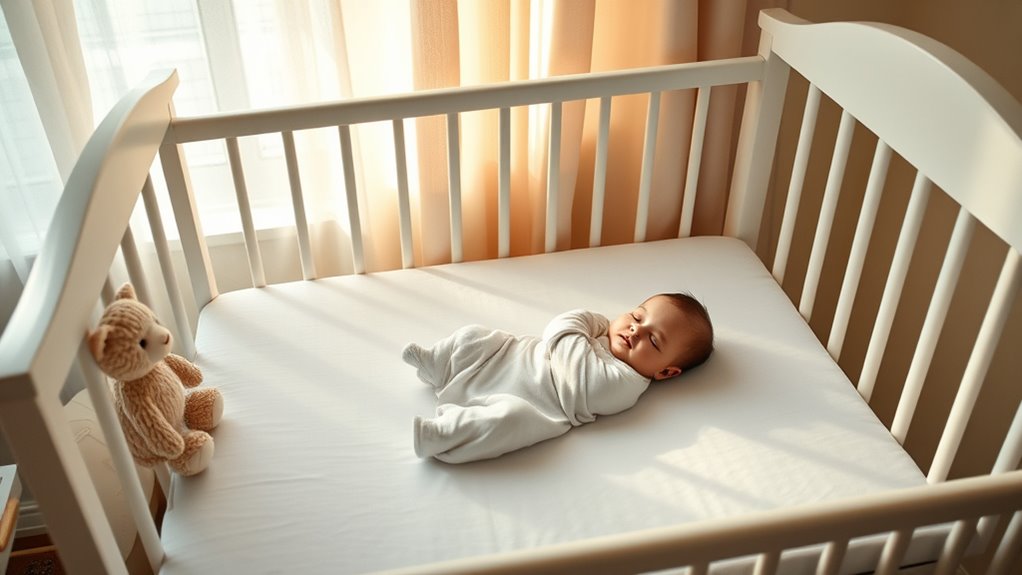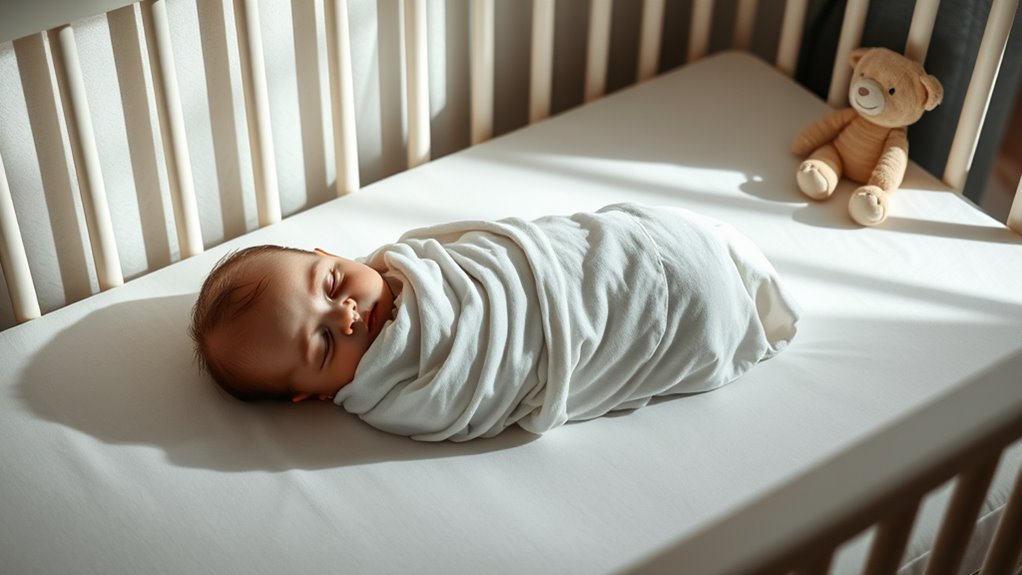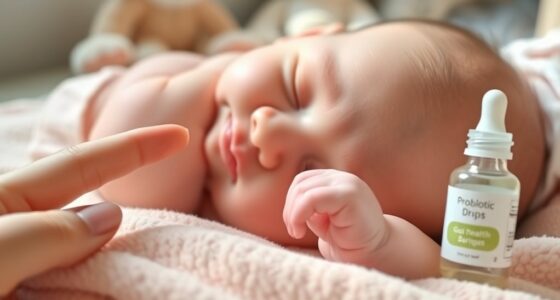To prevent SIDS, always place your baby on their back for sleep in a safe, firm, and snug crib with a fitted mattress. Keep the sleep area free of soft bedding, pillows, and stuffed animals, and guarantee the room is cool and well-ventilated. Avoid overheating by dressing your baby appropriately and using sleep sacks instead of loose blankets. Keep cords, blinds, and heavy curtains out of reach. For more essential tips, continue exploring safe sleep practices.
Key Takeaways
- Always place the baby on their back to sleep, reducing the risk of SIDS significantly.
- Use a firm, flat mattress with a snug-fitting sheet; avoid soft bedding and pillows.
- Keep the sleep area free of loose blankets, stuffed animals, and other soft items.
- Ensure the crib meets current safety standards and is free of broken or loose parts.
- Maintain a cool, well-ventilated room and avoid overbundling to prevent overheating.

Have you ever wondered if your sleep environment is truly safe? As a new parent, your top priority is keeping your baby safe during every nap and nighttime sleep. One vital aspect is ensuring proper crib safety, which involves more than just picking a sturdy crib. You need to make sure the crib meets current safety standards—no loose or broken parts, slats spaced appropriately to prevent your baby’s head from slipping through, and a firm, flat mattress that fits snugly without gaps. Avoid using soft bedding, pillows, or stuffed animals inside the crib, as these items can pose suffocation risks. Remember, a clutter-free, bare crib greatly reduces the chances of accidents and helps create a safe sleep zone for your little one.
Equally important is paying attention to your baby’s sleep position. Always place your baby on their back to sleep, as this position has been proven to drastically lower the risk of SIDS—Sudden Infant Death Syndrome. It might seem counterintuitive, especially if you’re used to the comfort of side or stomach sleeping, but back sleeping is the safest choice. When your baby is on their back, their airway stays open and unobstructed, reducing the likelihood of accidental suffocation or airway blockage. Make sure to gently but firmly position your baby on their back each time you put them down to sleep, even if they try to roll over later. Never place your baby on their stomach or side to sleep, as these positions have been linked to increased risks.
Another part of establishing safe sleep habits involves ensuring your baby’s sleep environment is consistent and free from hazards. Keep the sleep area in a cool, well-ventilated room, avoiding overheating by dressing your baby appropriately and not bundling them in too many blankets. Use a fitted sheet and avoid loose bedding or pillows that could cause suffocation or entrapment. If you’re concerned about your baby’s comfort, a sleep sack or wearable blanket is a safer alternative to loose blankets. Additionally, never place the crib near cords, blinds, or heavy curtains, which pose strangulation hazards. Making your baby’s sleep space safe and comfortable isn’t just about the right sleep position and crib safety; it’s about creating a consistent environment that minimizes risks and promotes healthy sleep patterns. Incorporating modern automation in your home can also help monitor your baby’s sleep environment for added safety.
Frequently Asked Questions
Are There Specific Sleep Positions That Increase SIDS Risk?
You should know that certain infant sleep postures, like placing your baby on their stomach or side, increase SIDS risk. For safe sleep positions, always put your baby on their back, which is the recommended safe sleep posture. This reduces the risk of suffocation and SIDS. Always make certain your baby’s sleep environment is safe, with a firm mattress and no loose bedding, to support safe sleep practices.
How Does Room Temperature Affect Sleep Safety?
You should know that room temperature impacts sleep environment safety by influencing your baby’s comfort and risk of overheating. Keep the room between 68-72°F to reduce SIDS risk, as an overly warm environment can cause overheating, which is linked to increased SIDS chances. Ensuring a comfortable, well-ventilated sleep space is essential for safe sleep, helping your baby stay cool and reducing potential hazards.
Should I Use a Pacifier During Sleep to Reduce SIDS Risk?
Thinking of a pacifier during your baby’s sleep? It’s like a cozy safety net—research shows pacifier benefits include reducing SIDS risk. However, be mindful of pacifier risks like dependency or choking hazards. If you choose to offer one, wait until breastfeeding is well-established and verify it’s clean and in good condition. Using a pacifier can be a simple step to help keep your little one safe and sound.
When Can My Baby Start Sleeping on Their Stomach?
You can typically start giving your baby tummy time during the day once they’re a few weeks old, but they shouldn’t sleep on their stomach until they’re at least 12 months old, according to safe sleep guidelines. During sleep training, always place your infant on their back for naps and nighttime sleep. Once your baby can roll over independently, they can sleep in their tummy, but always monitor them closely.
Are There Sleep Safety Considerations for Co-Sleeping?
When considering shared sleep or bed sharing, you should follow safe sleep guidelines to reduce risks. Always use a firm mattress, keep pillows or blankets away from your baby, and avoid bed sharing if you or your partner smoke or have consumed alcohol. Make sure your baby sleeps on their back, and keep the sleep area free of toys. Following these bed sharing guidelines helps promote your baby’s safety during sleep.
Conclusion
Think of your baby’s sleep environment as a delicate garden—you’re the gardener, tending carefully to each plant. By following safe sleep practices, you create a lush, protected space where your little one can thrive. Just as a gardener weeds out hazards, you remove risks like loose bedding and soft surfaces. With your vigilant care, you’re nurturing a safe haven, allowing your baby’s dreams to bloom peacefully and securely.









